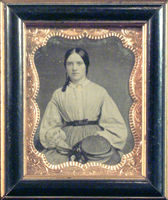
About The Civil War Letters

 |
About The Civil War Letters |
 |
![]()
|
William wrote the letters in this extensive collection to his wife Maggie throughout the War. The first letter in the collection was written on September 19th, 1861 at Camp Harlan near Washington DC. The last letter was written on March 27th, 1865 in an 11th Pennsylvania Cavalry Camp, probably near Richmond, VA. The collection contains on the order of 180 letters. The letters contain a mix of observation, historical facts, description of experiences, business matters and an outpouring of emotions of a very personal nature. Though almost all of the letters that Maggie sent to William (a comparable number to what William sent) have been lost, William's letters generally refer to the last letter from Maggie so one can get some idea of what Maggie had said in her letters. The style of each of William's letters is very similar. They almost always contain the location where written and the date of the letter clearly indicated at the top right. The salutation tends to be "Dear Maggie", "Dear Wife" or "My Dear Wife". The opening paragraph tends to refer to a letter he just received from Maggie, and possibly a statement that he is glad to hear that she is in good health (if she is) and an indication of his health. The signature block in most cases includes "Your Affectionate Husband", sometimes preceded by a statement of love, and the signature as "Wm Lancaster" or "William Lancaster". The letters were generally written on both sides of one sheet of paper with several formats. The most common format was a 4 page mini-book, where the paper was folded in half (usually horizontally, but sometimes vertically), and the letter starting on an outside page (page 1), continuing to pages 2 (on the back of page 1) and 3 on the inside, and finishing with the last page (page 4) on the back (of page 3). The last page was sometimes blank or contained just a signature block. Another style was the standard two-page letter written entirely across each page in "portrait" mode. Most of the letters were written on plain paper, but many were written on colorful stationary, which greatly enhance the letter. The original image versions of the letters will be presented in color and in their separate pages. The typed version will be presented as one letter with no distinction of pages. The letters were originally folded to fit into small envelopes. The typical envelope measured just 5 inches wide by 3 inches high, with some as small as 4.7 inches wide by 2.8 inches high. Most of the original envelopes that the letters came in have been preserved and are part of the collection. The condition of the original letters varies considerably, from excellent to poor. In some cases the entire letter is very legible, in others it is very difficult to read certain areas or in the worst case a piece of the letter is missing. One obvious cause of the variability is the difficulty in writing letters in the "field". In most cases William was able to use good quality ink, in a few he had to resort to using pencil. In some cases he may have had to write using his leg for support. Then there was the handling of the letters in the past. The letters were originally saved by Maggie in their envelopes. But at some point, all the letters were removed from their envelopes for presentation in a scrapbook. It would seem that there was a serious problem with the fragile letters so that much tearing occurred when they were removed. As a consequence, all the tears were connected with transparent tape, which has discolored and darkened over time, making the taped over areas difficult or impossible to read. On the plus side the taping did preserve the physical integrity of many of the letters. The letters were then taped into two scrapbooks, with several letters per page taped over each other which in some cases led to further deterioration of portions of the letters. The typed version of a letter is as true to the original as possible, maintaining spelling, punctuation and unusual capitalization. Formatting may be altered, and side notes fit in as best as possible. Some portions of the letters are difficult to read and some are just plain missing. A best guess will be made if possible. If not possible, some indication of the "missing" or "garbled" area of the letter will be indicated. The letters are accessed on-line via an envelope, hopefully the one that the letter was actually mailed in, However, the exercise of matching the envelopes to the letters brought about many problems. The postmarks on the envelopes are mostly legible, but some are smudged and difficult to read. Most lack the year. Also, there would generally be a delay between the date of the letter and the postmark date, which could be substantial in cases where he was writing from the field. In cases of uncertainly or total non-matching, a best guess was made or a generic envelope used for access. |